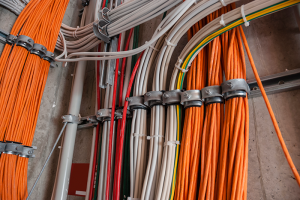Setting up an effective AEM program

Tracking current operations is an important part of developing an AEM program.
Image by Getty Images
The Centers for Medicare & Medicaid Services (CMS) in December 2013 published a notification that hospitals have the option of developing alternate equipment management (AEM) guidelines for aged mechanical, electrical, plumbing and air-handling equipment. As has existed for medical equipment, the concept was brought to older utility and system equipment for the environment of care.
Many hospitals have legacy equipment that is either so old no operating manual was published, or the manual was lost in the maintenance department’s multiple generations of leadership. The AEM is a basic approach to ensure equipment is handled optimally, performs to the needs of a hospital or other health care facility, and is a good alternative to relying on manufacturer’s requirements for maintenance.
Certain basics need to be accomplished to set up an AEM program. Based on the CMS memorandum of Dec. 20, 2013, (ref. S&C: 14-07-Hospital) areas to consider are the frequency of activities of the AEM program, deciding to place equipment on the AEM program, and evaluating the safety and effectiveness of the AEM program.
Understanding the equipment that is being maintained and what that requires is critical. This information also exists within preventive maintenance (PM) and work order systems to direct the technical staff on ensuring the equipment is running and to prevent failure. Such failure could be minor and fixed quickly or catastrophic with the piece of equipment needing total replacement, also known as run to failure (RTF).
AEM frequency
The original guidance around the frequency of the AEM program is described in the CMS document as “consistent with regulatory requirements to use maintenance activities or frequency of facility … equipment which may not be the same as those recommended by the manufacturer.” However, information from the manufacturer may be out of date or simply not available, which sets the stage for needing an AEM program in the first place.
The best approach to the frequency of the AEM program is to use regulatory requirements as a basis for setting up the maintenance program. The important thing to remember about regulatory requirements is that they are consensus-based practices from codes organizations that include feedback from vast arrays of industry experts.
Codes requirements and best practices are not mutually exclusive. In fact, the best AEM programs use codes to underpin the best practices employed when developing the program. In the health care field, however, there are so many codes and regulations that it is difficult to keep track. Aside from different codes and standards, there are different versions of which to be aware.
Codes in place when a component of the system is designed and installed is the best starting place and will likely be the best on which to base an AEM program. However, there may be an instance when a newer version will give relief for an otherwise tougher standard. It is very important for the facilities manager to understand the impacts of codes and standards on their existing equipment and to set up the frequency of the AEM program accordingly.
What is included?
There are two important aspects for deciding what does and doesn’t need to be on an AEM program: 1) qualified professionals need to determine what should be on it and 2) it should be determined what is considered “critical equipment.”
The decision team that adds equipment to the AEM program is more than just the facilities manager. Using the National Fire Protection Association’s NFPA 99, Health Care Facilities Code, risk categories (see sidebar at end of this article), the team should be comprised of those who understand the impacts of a piece of equipment should it fail. This team should include disciplines of infection prevention, clinical or biomedical engineering, and patient safety. In the case of specific facility equipment, leadership from the facilities management group would be considered qualified, but input from affected areas would reinforce the decision to form the AEM program.
Items the team should consider for the AEM program include level of complexity, use of appropriate maintenance strategies and any level of availability of manufacturer’s instructions. Performance history is also a critical set of data to bring to the team deciding the frequency. If the use of the equipment causes interference with the clinical environment, it may require adjustment to the AEM program.
Equipment not appropriate for an AEM program is straightforward but very important to understand. The CMS guidance from December 2013 outlines four basic categories of equipment that should not be included in an AEM program:
- The first category is any piece of equipment that is subject to specific maintenance, inspection and testing required by federal or state law.
- The second category is any piece of equipment required to have set maintenance protocols as part of the CMS Conditions of Participation (CoPs). Any equipment connected to a CoP is not allowed to deviate from those requirements in an alternate fashion. An example is a fire pump, which has very specific testing and maintenance requirements set forth in Chapter 5 of NFPA 25, Standard for the Inspection, Testing, and Maintenance of Water-Based Fire Protection Systems, which is referenced in NFPA 99.
- The third category is medical laser devices, which are governed by the Food and Drug Administration.
- The fourth category excludes newer equipment with available maintenance instructions from the manufacturer. This guards against a facility not following operational and maintenance manuals at the completion of a new project, only to introduce a lower maintenance standard.
This final category encourages a facility maintenance group to evaluate the impact of a new building on its program by acquiring the proper staffing and resources needed to properly maintain the equipment for optimal performance. A risk-based maintenance program can later be employed, but “the hospital must maintain evidence that it has first evaluated the maintenance track record, risks and tested the alternate regimen,” according to the CMS guidance.
Given budgetary constraints, RTF is sometimes a deliberate strategy to save capital and squeeze as much life out of a resource as possible. However, when these pieces of equipment are run past their useful lives, as with medical equipment, the risks increase.
In particular, the current focus on temperature and humidity everywhere from procedural rooms where a patient is being treated to storage areas where a manufacturer’s “instructions for use” require a certain temperature and humidity is causing the risks of failure to come under scrutiny. This is where the AEM program is an important tool to ensure that these environmental conditions are met and do not place a patient at risk.
Decision process
The basic elements of the decision process for including equipment in an AEM program are the type of equipment, the age of equipment and the projected useful life of the equipment.
The type of equipment covers whether it’s mechanical equipment, electrical equipment or plumbing. For mechanical equipment, air-handling units and chilled water are the most important pieces. However, what may be considered one piece of equipment may have many components that need an AEM program. For example, an air handler’s motors and associated sheaves, coils and evaporators each have a useful life within them. These individual components are also subject to failure and therefore subject to some level of PM. The best approach for these systems, or these more complex pieces, is to have a detailed list of these components and how they are checked.
The age of equipment is key to establishing the AEM program. Although maintenance shops are very successful at keeping older pieces of equipment running, replacement parts become hard to find. Most facilities managers have direct experience with pieces of equipment long past their useful lives (sometimes 35 or 40 years old) that are running at 98% of their original design capacity. This is where maintenance departments are celebrated: doing more with less.
However, the older these pieces of equipment get, the more difficult it is to find parts. If the manufacturer stops producing parts for a unit or the manufacturer is no longer even in business, it is very difficult to properly maintain the unit. The AEM program can describe how these units are replaced and recovered if there is routine maintenance of replacement parts or if there is a catastrophic failure. It also helps guide which parts can be stocked and switched out quickly during a failure, triggering the ordering of a new part that may take some time to be received.
The expected age of life is often debated and prioritized within health care organizations. From a capital funding perspective, this area is in direct competition with medical equipment and other bedside resources. Understanding a piece of equipment’s age of life, and how far past that age of life the equipment is being maintained, helps determine when total replacement is necessary. At the same time, it is important to understand how to maintain a newer piece of equipment early in its life to make sure that the expected age of life is on track to optimize the investment. In many instances, PM is not done on newer equipment, which shortens its expected life cycle.
The importance of these elements goes into the AEM program. It is important to differentiate those that have the recommended manufacturer’s PM, which is more common for newer equipment, and what should be identified in the overall equipment list. The older pieces of equipment need the AEM program to be more explicit on steps that are being taken by the maintenance department to make sure that things are going well.
An AEM program offers some level of flexibility and reflects the activity the maintenance department does in good practice to keep these units running, taking those 35- and 40-year-old units that are past their useful lives and whose manufacturers have long ago closed.
The maintenance team has a deliberate set of steps to ensure the unit is running correctly. This may involve replacing the component parts of the individual pieces, such as the motors or coils, but keeps the overall unit still functioning. Tracking when those component parts were replaced is an important part of the AEM program.
The status of replacement parts helps understand where the unit stands in its useful life and comes into the conversation about total replacement. If a unit has brand-new motors and coils replaced in its overall system, and they are only a year or two old, the facility can decide that the main components have more useful life in them. This enables capital resources to be spent closer to the bedside, which is always desired.
The AEM program should also be revisited on an annual basis because of constant construction or changing out of equipment on a regular basis. An annual review also coincides with capital planning cycles. If an individual unit or component of a system is removed and replaced, the AEM program needs to be accurately tracked and modified to make sure that the scope is accurate.
This demonstrates focused knowledge of the physical plant and eliminates the need to do regular PM tasks on equipment that does not exist. This cleans up the work order system and has the maintenance crew working very efficiently on the equipment that is there. From a regulatory perspective, it demonstrates that the facilities manager is on top of the equipment that they have when an inspection of the environment of care or life safety systems comes through.
A team effort
Above all, development and maintenance of the AEM program is a team effort.
This could be a central tool for leadership and supervision of the maintenance department to work with the front-line technicians and collaborate on knowledge and best practices on how to maintain these pieces of equipment born out of the medical equipment concepts.
The AEM program provides similar collaboration among all levels of the maintenance staff for the good of the patient to maintain a healing environment and improve patient satisfaction.
Reviewing system risk categories in the 2012 edition of NFPA 99
One of the main foundations of forming an alternate equipment management (AEM) program is understanding the four risk categories described in the National Fire Protection Association’s NFPA 99, Health Care Facility Code.
In the 2012 version of NFPA 99, which is currently adopted and enforced by the Centers for Medicare & Medicaid Services, they are described in Chapter 4. Each category is established based on the level of harm to patients and caregivers alike if they result in failure.
- Category 1 systems, which represent the highest risk, are “likely to cause major injury or death” and are the most critical in a health care facility.
- Category 2 systems, although still very important, only would result in “minor injury.” Any outcome resulting in injury should be given priority in terms of planning.
- Category 3 systems would not result in any kind of injury but would result in “patient discomfort” in the event of failure.
- Category 4 systems, the least impactful of all, have “no impact on patient care” but still carry some level of requirement.
As systems are designed with these categories in mind, so should any AEM program. Category 1 systems should be of the highest priority when establishing AEM programs, while Category 4 can have more flexibility for an AEM program.
For specific requirements of each category on systems such as gas and vacuum, electrical, plumbing, HVAC and information technology, facilities professionals should refer to NFPA 99.
About this article
This is one of a series of articles contributed by the American Society for Health Care Engineering’s Member Tools Task Force.
Jeffrey O’Neill, AIA, is vice president of plant operations at Robert Wood Johnson University Hospital, RWJBarnabas Health, in New Brunswick, N.J. He can be reached at jeffrey.oneill@rwjbh.org.




